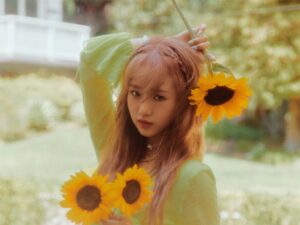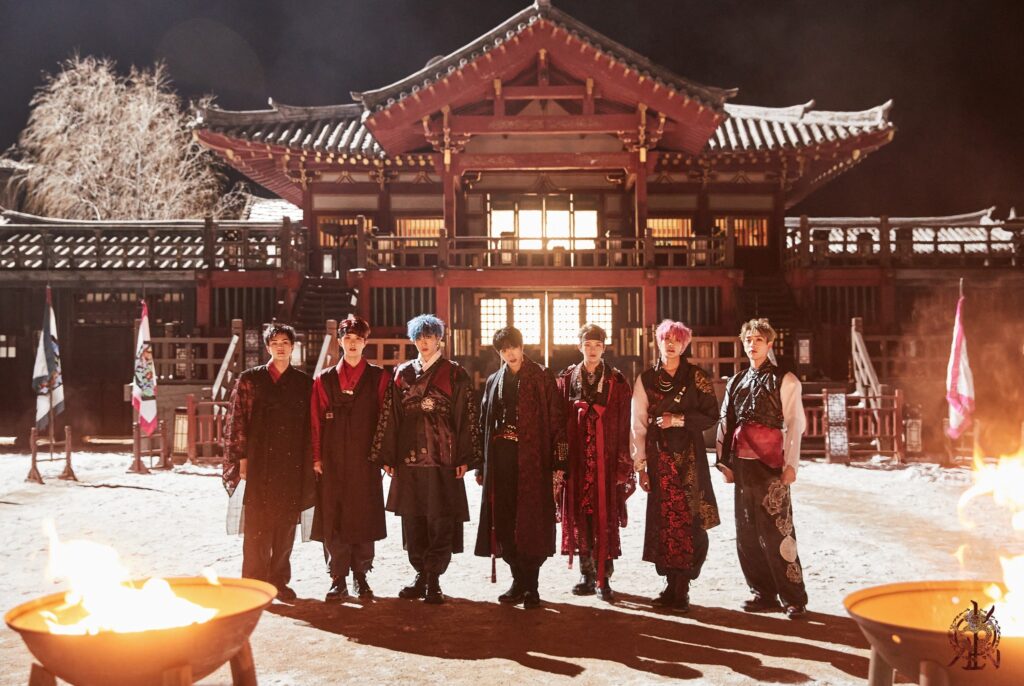The End-of-Year Reviews are upon us again. Amidst holiday festivities of the season, our writers wade through a stunning number of releases from the K-pop scene to highlight what stood out from the past year.
Following the debuts review, Sophie and Qing discuss what makes for strong choreography, how solo artists fare against groups, and how dances transform motion into emotion.

Qing: It’s interesting that our picks are so different, but two themes stand out: solo artists and rookies. Just to lay some groundwork, what makes a dance stand out for you, Sophie?
Sophie: I had nothing specific in mind while watching the dances, but I noticed after the fact that one quality that guided my choices was how a choreography makes use of space. I think one reason solo artists stand out is that, ironically, they utilize the stage more fully than group choreography allows for (this Wonho number, which was in my top 10 but I sadly had to cut, is a great example!).

What really makes me fall in love with a dance, though, is if it changes my experience of a song and helps me “hear” it differently: in other words, the musicality. This is what made me so enamored with the choreography for Choi Yoojung’s “Sunflower”!
Confession time: when I first heard this song, I liked it but found it a tad generic. But when I stumbled across this choreography, I was impressed by how this dance built in “levels” to the track–structure that wasn’t immediately apparent in the song–and was attuned to details in the instrumental.
Above all, it is so playful and happy, capturing the spirit of what a song like “Sunflower” should be! I was really struck by the unusual formations–they almost felt like a butterfly flapping their wings, ever-shifting across the stage. The end, when they all rally around Yoojung in a circle, was so cute and unexpected!
I’m so excited to hear about what stands out to you, as a veteran of this process. What catches your eye when you experience a dance?
Qing: I first look out for technical details: body movements, transitions, formations, and the use of levels and depth of field. Then I think about the mood or message these details convey, and how they respond to the music. As you noted, the best choreographies don’t just give visual form to the song’s core emotion or story; they also draw your attention to musical details.
Changmin‘s “Devil” expresses the minute inflections of his vocal delivery–the centrepiece of the song. Swift but soft hand and arm movements accompany his opening drawl as he voices the tempting whispers of the titular devil. The dancers’ limbs strain upwards and pelt down in the chorus as Changmin belts, “Rain down on me”, tracing the rise and fall of the vocals.
“Devil” exudes power, but this power isn’t explosive chaos; it’s controlled mastery. It’s no surprise, then, that the dance is all about hands and arms–the locus of control in a human body–casting Changmin in the role of a puppet master at times, and an orchestra conductor at others. There’s hardly a more perfect way to demonstrate who he is as a veteran artist: virtuosic, assured, captivating.
Changmin’s junior labelmate, Exo‘s Xiumin, made your list with a delicate but no less compelling dance. What drew you to it?

Sophie: The most impactful performances feel like they have nothing to prove. Xiumin’s “Serenity” won my heart because it is just that–inestimably heartfelt. Also, an entirely contemporary-based dance routine is a mythical creature in K-pop!
Aside from the beautiful choreography, I was touched by how openhearted this piece is. In its unbridled gentleness, along with the wave-like ebbs and flows of the dance, “Serenity” feels like a moving meditation: the perfect antidote to the generalized angst many of us have been feeling these pandemic times.
The movements are delicate and sweeping, and bodies gradually unfurl like flowers soaking in rays of sunlight. There is such an appreciation for movement, and the simple pleasure that it is just to move, in this piece. It is unhurried, and many moments center purely on the power of connection. For example, the dancers often rest their heads on each other’s shoulders and prop each other up, while gazing in seeming wonderment at the space around them.
The dance feels like an extended caress, and there is power to be found in the delicacy and wonder it sweeps us in. I was so moved by it, and hope it is a harbinger of more contemporary-based dance routines in 2023!
Another dance that goes against the hip-hop grain is Kwon Eunbi’s “Underwater”. Befitting the title, it undulates with gorgeous lines and movement throughout! I’d love to hear what speaks to you about this piece.
Qing: Reframing your words, “Underwater” moulds itself closely around Eunbi’s artistic image. Both song and dance present her as a siren–a mythological sea creature that lured sailors to destruction with her singing. The movements are subtly yet persistently seductive, coming through in fluid sweeps of the arm, in arching bodies and heads tossed back. The sensuality of slower moves is heightened by the contrast with nimble footwork and quick wrist movements.
But there’s also a sense of whimsy in the aquatic motifs that keeps “Underwater” youthful: Eunbi’s mermaid pose, her diving action and wiggling fingers that mimic bubbles, and the backup dancers’ arm waves that resemble seaweed swaying with the currents.
The use of depth of field is excellent. It pushes Eunbi and her crew forward as she makes her advances on the viewer. During the second hazy, bass-filled pre-chorus that makes her voice sound submerged in water, she’s visually drawn into the background, just like her singing.
Like “Underwater”, Kim Yohan‘s “Dessert” (which made my Mid-year Review list) is sensual and seductive. It modulates between fluid, disco- and voguing-style arm and waist movements, and sharper moves influenced by popping. In the chorus, Yohan uses his fingers–especially his pinky–with a delicious delicacy as he plucks and pops a pretend cherry into his mouth.
I admire Yohan’s confidence in expressing such feminine movements. The choreographer’s choices not only succeed in differentiating Yohan as an artist, but also leans into the rich expressiveness of alternate dance styles. There’s more nuance and impact to the sensuality here, compared to the hip thrusts that male artists’ sexier releases often default to.
Speaking of sexy, how did Hyolyn‘s “No Thanks” make your list?
Sophie: I love the poetry with which you describe “Underwater’s” balance of whimsy and sensuality. In that regard, I knew I had to include Hyolyn on this list, because she is the pinnacle of self-assured sensuality in K-pop. To watch her dance is like watching an artist delight in smearing paint across a blank canvas. She’s so at ease with herself on stage, and though she often casts herself in the role of seductress, it never feels manufactured.
I was torn between two Hyolyn dances for this list: ”No Thanks,” my ultimate pick, and “Layin’ Low.” Ultimately, I chose “No Thanks” because it’s sensual while also exuding playfulness, which is unusual. Some “sexy” dances take themselves a bit too seriously, which can lessen their appeal. “No Thanks,” meanwhile, is chock-full of irreverent touches, including interludes of popping that create compelling contrast with the overt femininity of the choreography.

I love how this piece subverts expectations by favoring an upbeat, bouncy approach. It exudes attitude, is super fun, and is totally aligned with Hyolyn’s identity as an artist. To be honest, she could carry any dance with the force of her charisma alone, but the combined alchemy of Hyolyn with the fun choreography, plus her easy rapport with her dancers, makes “No Thanks” a complete blast.
But when it comes to dances that exude fun, whoa! I was not prepared for TO1’s “Drummin,” which is like an amusement park ride come to life! I can’t wait to hear how you describe this one.
Qing: “Drummin'”‘s concept is simple: a love interest has knocked TO1 off their feet, and they express their excitement and joy through drumming. The choreography fully expresses the exuberance of a young crush.
The titular motif comes through at the outset. TO1 form a drum set with their arms, and a drumming motion resurfaces in the chorus point move. These are accompanied by rapid motions (pumping) and body angles (leaning sideways and forwards) that further express joy.
The song’s persona can’t keep still for their excitement over this crush; likewise, the formations hardly stay the same. The choreography moves TO1 from group diamond formations into units, and they alternately role-play a dance crew hyping up their friends and a b-boy crew judging their rivals in a mock-face-off.
The bridge reveals a moment of surprising vulnerability with a plain appeal–”I want you”. The choreography mirrors this with delicate hand movements. This sincerity adds emotional nuance to the otherwise energetic release.
On the note of fun dances, what did you like about Adora‘s “Magical Symphony”?
Sophie: The dynamism you highlight in “Drummin” is one of the elements that made me enamored with “Magical Symphony!” This piece draws upon a rich medley of genres, and I love the vaguely Old Hollywood musical feel of the jazz- and tap-inspired moves.
I also love how the choreography includes frequent lyrical nods. Adora sings that the dancing lights of a chandelier “match their footwork,” and a few lines later she talks about “drawing a circle” as she and her dancers arc their bodies, creating circles with their hands. Almost every lyric is somehow translated physically into the choreography. These little gestures make the dance a treasure trove that rewards repeat watches.
Beyond its inventiveness and attention to detail, though, “Magical Symphony” is infectious in its exuberance. It exudes a joy for movement that is so inspiring!
Craxy’s “Poison Rose,” my one group pick, won my heart for similar reasons, though the tenor of the piece is totally different. This dance had me in awe because of how well-crafted and intriguingly layered it is–no easy feat in K-pop, and yet it’s shockingly under the radar!
There are countless movements worth commenting on, from the hypnotic opening, to an enthralling part of the bridge when the members spin themselves around the floor with only one hand, which requires an insane level of forearm strength.
“Poison Rose” explores different planes of motion as well, and makes masterful use of depth of stage. It’s spellbinding from beginning to end. I hadn’t explored Craxy’s music before stumbling upon this dance, so this was a serendipitous find for me and signals future greatness!

Qing: Kingdom‘s “Ascension“–another stayer from my Mid-year Review list–drew me in with a theatricality that’s similar to Craxy’s. The boldness of its fusion style remains captivating, even when stacked against releases from the rest of the year.
I previously highlighted the inventive use of props and backup dancers to give form to the song’s narrative of entanglement, but also noted that Kingdom’s delivery of the traditional talchum-inspired choreography left a bit to be desired. This is remedied in a more recent dance practice video.
The video only features the members, and shows the strength of the choreography. Even without a large dance crew and props, the chorus exudes grandiosity with its drumming motions and talchum-style arm-swinging. The verses evoke emotion through unusual, elegant arm movements, such as Dan‘s arms unfolding and folding like a traditional wooden door latch in the pre-chorus.
Looking at our discussion overall, it’s exciting that seven of our ten picks are rookies. As more experienced groups embark on world tours, a space opens up for newer artists to establish their footing in the industry. I can’t wait to see the creativity and wonder that they will continue to unleash in the coming year.
(YouTube [1][2][3][4][5][6][7][8][9]. Images via Fantagio Entertainment, SM Entertainment, Bridʒ, GF Entertainment)
0 Comments